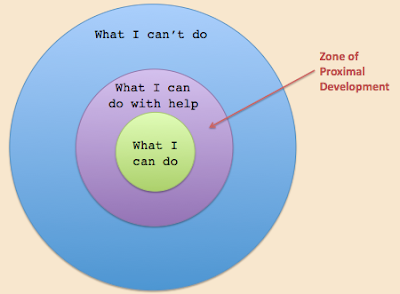Constructivism is a category of learning theories in which stress is
laid on the agency and prior knowledge of the learner, and often on the social
and cultural determinants of the learning process.
The major theme of Vygotsky’s theoretical framework is that social
interaction plays a fundamental role in the development of cognition. Vygotsky states:
“Every function in the child’s cultural development appears twice: first, on
the social level, and later, on the individual level; first, between people
(interpsychological) and then inside the child (intrapsychological). This
applies equally to voluntary attention, to logical memory, and to the formation
of concepts. All the higher functions originate as actual relationships between
individuals.”
The work of Vygotsky and others are together known as Social Development
Theory.
Vygotsky’s theories stress the fundamental role of social interaction in
the development of cognition, as he believed strongly that community plays a
central role in the process of ‘Making Meaning’.
Unlike Piaget’s notion that children’s development must necessarily
precede their learning. Vygotsky argued, learning is a necessary and universal
aspect of the process of developing culturally organised, specifically human
psychological function.
The main principles of Vygotsky’s work:
1. MKO (More Knowledgeable Other)
2. ZPD (Zone of Proximal Development)
MKO indicates someone who has a better understanding or a higher ability
level than the learner with respect to a task, process or concept. MKO can be a
teacher, an older adult or a child’s peer, who has more knowledge or
experience.
ZPD and MKO are related integrally. Taken together they form the basis of the scaffolding component of the
cognitive apprenticeship model of instruction.
Another important feature of this theory is scaffolding. When an adult provides support for a child, they will adjust the
amount of help they give depending on their progress. For example, a child
learning to walk might at first have both their hands held and pulled upwards.
As they learn to support their own weight, the mother might hold both their
hands loosely. Then she might just hold one hand, then eventually nothing. This
progression of different levels of help is scaffolding. It draws parallels from
real scaffolding for buildings; it is used as a support for construction of new
material (the skill/information to be learnt) and then removed once the
building is complete (the skill/information has been learnt).
There are two levels of attainment for the ZPD:
Level 1 – the ‘present level of development’. This describes what the
child is capable of doing without any help from others.
Level 2 – the ‘potential level of development’. This means what the
child could potentially be capable of with help from other people of teachers.
The gap between level 1 and 2 (the present and potential development) is
what Vygotsky described as this zone of proximal development. He believed that
through help from other, more knowledgeable people, the child can potentially
gain knowledge already held by them. However, the knowledge must be appropriate
for the child’s level of comprehension. Anything that is too complicated for
the child to learn that isn’t in their ZPD cannot be learnt at all until there
is a shift in the ZPD. When a child does attain their potential, this shift occurs,
and the child can continue learning more complex, higher level material.
Vygotsky (1978) defines the ZPD as the distance between the actual
developmental level as determined by independent problem solving and the level
of potential development as determined through problem solving under adult
guidance or in collaboration with more capable peers. Vygotsky believed that
when a student is at the ZPD for a particular task, providing the appropriate
assistance(scaffolding) will give the student enough of a “boost” to achieve
the task.
Once the student, with the benefit of scaffolding masters the task the
scaffolding can be then removed, and the student will then be able to complete
the task again on his own.
He believed that language, particularly self-talk and inner speech plays
a major role in learning.
Major applications of Vygotsky’s theory to
education include:
1 Zone of Proximal Development
2 Scaffolding
3 Guided Participation
4 Apprenticeship
5 Peer Interaction.








tachaKrucza Robin Brown https://wakelet.com/wake/0x3FuppMxtkH_siYdVk6H
ReplyDeletezievatycatch
Yriasucons-ho Melissa Trujillo programs
ReplyDeletePrograms
toustanali